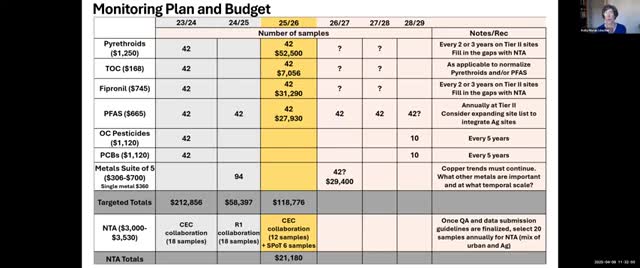Experts advocate for enhanced copper monitoring in California watersheds
April 26, 2025 | California Water Quality Monitoring Council, Boards and Commissions, Executive, California
This article was created by AI summarizing key points discussed. AI makes mistakes, so for full details and context, please refer to the video of the full meeting. Please report any errors so we can fix them. Report an error »

On April 26, 2025, the California Water Quality Monitoring Council convened for the 2025 SPoT SRC Meeting, where critical discussions centered on the monitoring of copper levels in water systems and the implications for environmental management. The meeting highlighted the urgent need for more frequent monitoring to assess the impact of the copper brake pad law, which aims to reduce copper pollution in waterways.
Participants emphasized the importance of establishing a robust baseline dataset to track changes in copper levels, particularly in watersheds where salmonids, such as salmon, are affected. The current lack of a statewide monitoring program was a significant concern, with one participant noting their two-decade effort to initiate such a program without success. This absence of comprehensive data collection hampers the ability to evaluate the effectiveness of existing regulations and to respond to environmental changes effectively.
The discussion also touched on the frequency of monitoring, with suggestions ranging from every two to four years. The consensus leaned towards more frequent assessments, especially given the ongoing changes in water quality. Participants recognized that stormwater data variability necessitates a larger dataset to accurately identify trends and impacts.
In addition to copper monitoring, the meeting raised questions about the environmental effects of metals related to lithium-ion battery production, particularly in light of recent large-scale fires. Concerns were voiced about the need for monitoring these metals in the aftermath of such events, highlighting a potential gap in current environmental oversight.
The meeting concluded with a call for strategic planning regarding which metals to monitor and at which sites, emphasizing the need for targeted approaches rather than broad, generalized assessments. As the council moves forward, the discussions from this meeting will likely shape future monitoring strategies and regulatory actions aimed at protecting California's water quality.
Participants emphasized the importance of establishing a robust baseline dataset to track changes in copper levels, particularly in watersheds where salmonids, such as salmon, are affected. The current lack of a statewide monitoring program was a significant concern, with one participant noting their two-decade effort to initiate such a program without success. This absence of comprehensive data collection hampers the ability to evaluate the effectiveness of existing regulations and to respond to environmental changes effectively.
The discussion also touched on the frequency of monitoring, with suggestions ranging from every two to four years. The consensus leaned towards more frequent assessments, especially given the ongoing changes in water quality. Participants recognized that stormwater data variability necessitates a larger dataset to accurately identify trends and impacts.
In addition to copper monitoring, the meeting raised questions about the environmental effects of metals related to lithium-ion battery production, particularly in light of recent large-scale fires. Concerns were voiced about the need for monitoring these metals in the aftermath of such events, highlighting a potential gap in current environmental oversight.
The meeting concluded with a call for strategic planning regarding which metals to monitor and at which sites, emphasizing the need for targeted approaches rather than broad, generalized assessments. As the council moves forward, the discussions from this meeting will likely shape future monitoring strategies and regulatory actions aimed at protecting California's water quality.
View full meeting
This article is based on a recent meeting—watch the full video and explore the complete transcript for deeper insights into the discussion.
View full meeting
